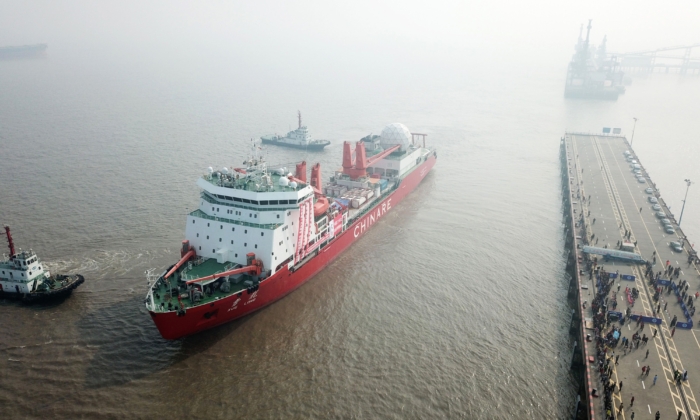‘This recent activity demonstrates the increased interest in the Arctic by our strategic competitors,’ a senior U.S. military official said.
China’s coast guard announced on Oct. 2 that its vessels sailed into the Arctic Ocean for the first time, conducting patrols alongside Russian ships in the waters where Beijing has long sought to project power.
The Chinese vessels entered the Arctic Ocean during the seven-day public holiday marking the Chinese Communist Party’s 75-year rule, which began on Oct. 1, according to state broadcaster CCTV.
In a separate statement, China’s defense ministry said that the patrol effectively expanded its coast guard’s ocean navigation scope, “comprehensively tested their vessel’s capability to perform tasks in unfamiliar waters, and provided strong support for engaging in international and regional ocean governance.”
The U.S. Coast Guard said on Oct. 1 that it observed two Chinese ships and two Russian ships navigating through the Bering Sea, a narrow strait separating Alaska from Russia.
These ships were spotted by a U.S. Coast Guard airplane during its routine patrol on Sept. 28 and were approximately 5 miles inside Russia’s exclusive economic zone, the U.S. Coast Guard said in a statement. This marked the farthest northern point at which the U.S. Coast Guard observed the presence of Chinese vessels, it added.
Rear Adm. Megan Dean, commander of the 17th Coast Guard District, said in a statement that this recent activity demonstrates “the increased interest in the Arctic” by the United States’s strategic competitors.
China’s Arctic Ambition
Analysts have anticipated an increased Chinese military presence in the Arctic as the Chinese Communist Party (CCP) aims to assert its influence through new economic and military initiatives in the region.
China claims to be a near-Arctic state and has expressed interest in accessing the Arctic Ocean’s abundant natural resources, such as oil, natural gas, and rare earth metals, as well as developing shipping routes.
To push into the Arctic’s bounty, China has added the “Polar Silk Road” to its Belt and Road Initiative, a multibillion-dollar project aimed at bolstering the CCP’s geopolitical influence by building ports, railways, and other infrastructure worldwide. According to the plan first unveiled in 2017, Beijing said it would encourage enterprises to build infrastructure and conduct commercial trial voyages, paving the way for Arctic shipping routes that would form a Polar Silk Road.
‘Uptick’ in Chinese, Russian Military Activities
The U.S. Coast Guard has observed an “uptick” in Chinese and Russian military presence in the areas near Alaska and the North Pacific, according to Vice Adm. Andrew Tiongson, the commander of the U.S. Coast Guard Pacific Area.
“Occasionally … we see some of those vessels that I described earlier that come into our portion of the maritime boundary,” Tiongson told reporters in a digital briefing on Sept. 27.
“Can they do that? The answer is yes. It’s still international waters. But it is part of our exclusive economic zone, so we have sovereignty there.”
Tiongson said the U.S. military’s response is to “meet presence with presence.”
“When they go out there, we ensure that they know we’re there. We establish communications. Sometimes, they tell us that they’re just transiting through and they’ll be out of our EEZ very soon, and other times, we sit and we watch and shadow them as they go forward,” he said.
The U.S. Coast Guard has shared the related information with the Department of Defense and U.S. ally Canada, Tiongson said, adding that the U.S. encounters are “very professional” to date.
The growing cooperation between China and Russia in the Arctic region has alerted the United States.
In July, Pentagon leadership released a strategy report that aims to bolster U.S. Arctic capabilities through increased cooperation with allies in the face of aggression by Beijing and Moscow.
Last month, the U.S. Army sent more than 100 soldiers to Shemya Island. Sen. Dan Sullivan (R-Alaska), a member of the Senate Armed Services Committee, said a guided missile destroyer and a U.S. Coast Guard vessel were also deployed to the western region of Alaska.
Shemya, which hosts an air station, is about 1,200 miles southwest of Alaska’s Aleutian chain but less than 300 miles from Russia.
Officials said the deployment was in response to the recent Russian and Chinese war games near U.S. territory.
“As the number of adversarial exercises increases around Alaska and throughout the region, including June’s joint Russian–Chinese bomber patrol, the operation to Shemya Island demonstrates the division’s ability to respond to events in the Indo-Pacific or across the globe, with a ready, lethal force within hours,” Maj. Gen. Joseph Hilbert, the commander of the 11th Airborne Division of the U.S. Army, said in a statement.
Reuters and Andrew Thornebrooke contributed to this report.

